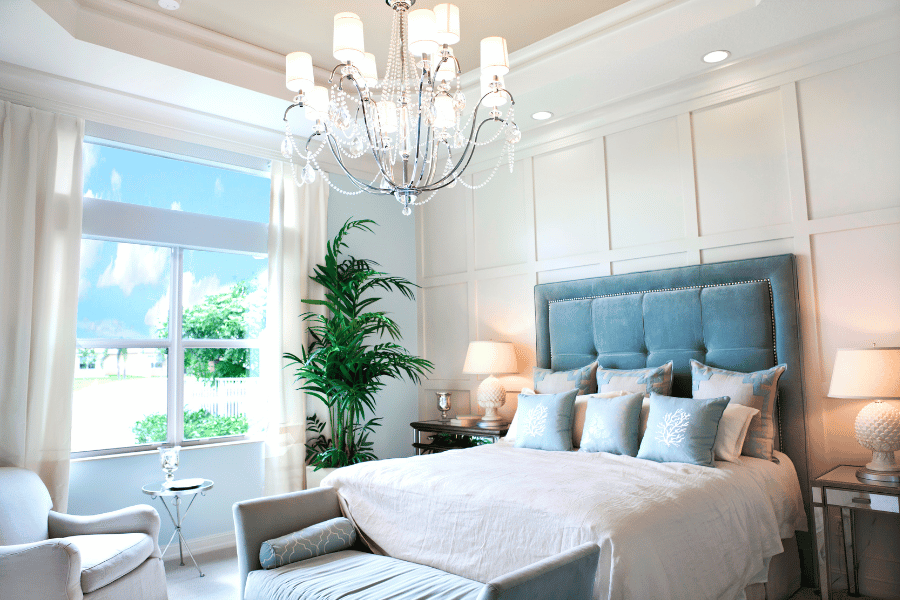When designing a bedroom, color selection is one of the most crucial choices you can make. Colors have a significant impact on our emotions, energy levels, and overall well-being.
If your goal is to create a peaceful retreat that promotes relaxation and better sleep, choosing the right hues for your walls, bedding, and décor is essential.
Research shows that certain colors naturally encourage tranquility and restfulness, while others can be too stimulating for a sleep-friendly space.
In this blog post, we’ll explore the best bedroom colors for relaxation and why they work so well.

1. Soft Blues: The Ultimate Sleep-Inducing Hue
Soft blue shades are widely regarded as the best choice for a restful bedroom. Blue tones mimic the sky and ocean, creating a sense of calm and stability. Studies have shown that blue rooms can actually lower blood pressure and heart rate, making it easier to fall asleep and stay asleep.
Best Blue Shades for Bedrooms:
- Pale Blue – A light, airy shade that gives a fresh and soothing feel.
- Powder Blue – Soft and delicate, perfect for creating a spa-like atmosphere.
- Muted Blue-Greens – A blend of blue and green that evokes serenity and balance.
Pair blue walls with crisp white bedding, natural wood furniture, or soft gray accents for an inviting and peaceful ambiance.
2. Gentle Greens: Nature’s Calming Influence
Green is another excellent choice for a relaxing bedroom because it represents nature, growth, and renewal. Soft green hues can make a space feel refreshing yet cozy, encouraging restfulness while also uplifting your mood.
Best Green Shades for Bedrooms:
- Sage Green – A muted, earthy green that pairs beautifully with neutral tones.
- Mint Green – Light and airy, providing a fresh yet relaxing vibe.
- Olive Green – A deeper, grounding shade that creates a cozy retreat.
Combine green tones with warm wood finishes, off-white linens, and subtle metallic accents for a well-balanced, serene space.
3. Warm Neutrals: Cozy and Soothing
Neutral tones are timeless, versatile, and ideal for fostering a sense of warmth and relaxation. The right neutral shade can make a bedroom feel inviting without being overwhelming.
Best Neutral Shades for Bedrooms:
- Soft Beige – A warm, sandy shade that adds coziness.
- Warm Gray – A perfect balance between cool and warm tones for a sophisticated look.
- Creamy White – An off-white option that feels soft and welcoming rather than stark.
Neutrals pair beautifully with natural materials like linen, wool, and wood, enhancing the overall comfort of your bedroom retreat.
4. Muted Lavenders: A Touch of Elegance and Calm
While purple is often associated with creativity and energy, softer shades of lavender and lilac can have a deeply calming effect. These hues add a touch of luxury while maintaining a restful ambiance.
Best Lavender Shades for Bedrooms:
- Pale Lavender – A delicate, airy hue that feels dreamy and elegant.
- Dusty Lilac – A muted tone with gray undertones that adds subtle sophistication.
- Soft Mauve – A slightly deeper option that still feels serene and comforting.
To prevent lavender tones from feeling too bright, pair them with soft neutrals, muted grays, or gentle blues.
5. Earthy Tones: Grounding and Tranquil
Earthy shades like terracotta, warm taupe, and muted peach can create a cozy, cocoon-like atmosphere that encourages relaxation. These colors are perfect for those who prefer warm, grounding tones over cooler hues.
Best Earthy Shades for Bedrooms:
- Warm Taupe – A soft brown-gray that adds subtle depth without overpowering the room.
- Muted Terracotta – A gentle clay-like hue that feels both inviting and sophisticated.
- Peachy Beige – A light, warm tone that exudes comfort and relaxation.
Pair earthy colors with natural fibers, soft lighting, and textured décor elements to create a peaceful, harmonious bedroom.
Colors to Avoid in a Relaxing Bedroom
While personal preference plays a significant role in color selection, some shades are naturally more stimulating than soothing. Avoid overly bold or intense colors that can make it harder to wind down, such as:
- Bright Reds & Oranges – These energetic hues can increase heart rate and alertness.
- Vibrant Yellows – While cheerful, bright yellow tones can be overstimulating in a sleep environment.
- Neon or Highly Saturated Colors – These shades can be jarring and disruptive to relaxation.
If you love bold colors, consider incorporating them as accent pieces rather than main wall colors.
Final Thoughts
Your bedroom should be a sanctuary—a place where you can unwind and recharge. Choosing calming colors such as soft blues, greens, warm neutrals, muted lavenders, and earthy tones can help set the tone for a restful and rejuvenating space.
When selecting paint colors, test a few swatches in different lighting conditions to see how they appear throughout the day. Combine soothing wall colors with plush bedding, gentle lighting, and natural textures to enhance the overall feeling of relaxation.
With the right color palette, you can transform your bedroom into a peaceful retreat that promotes better sleep and relaxation every night.

Leave a Reply